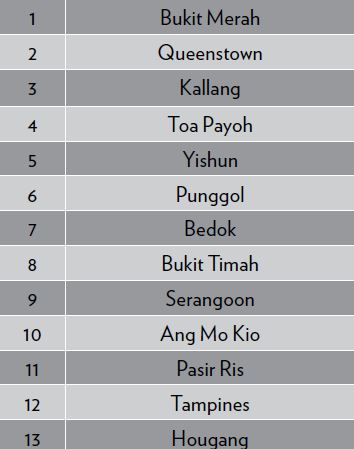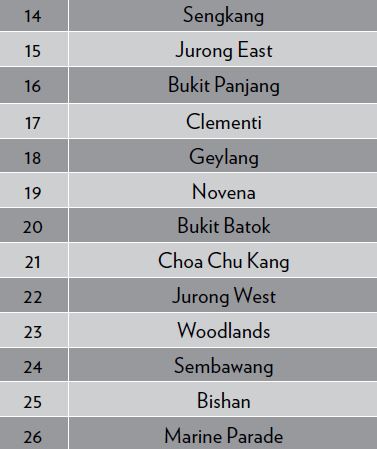Food costs are going up — according to the Department of Statistics, food prices have risen 2.2 per cent a year since September 2015. This would inevitably affect the price of hawker food, which most Singaporeans enjoy. According to a 2014 report on food trends by public relations firm Weber Shandwick, four in five of more than 750 Singaporean adults interviewed said they eat at hawker centres when not dining at home.
To study the differences in the cost of dining out across neighbourhoods, the IPS Social Lab conducted a survey of hawker food prices across the island. In July 2016, we recorded the cost of a selected menu of seven hawker food items (chicken rice, chicken biryani, nasi goreng, rice with two vegetable dishes and one meat option, rice with one vegetable dish and two meat options, iced milo and black coffee with sugar) in over 80 locations across 26 neighbourhoods) from Pasir Ris to Jurong West.
We then averaged the cost of each item for each neighbourhood and summed them up to achieve a total price index for hawker food. In some districts, such as Tanglin and Orchard, insufficient data points, or scarcity of hawker centres, meant that we had to exclude them from the rankings. This was the list we came up with (Table 1), with 1 being the least expensive, and 26 being the most expensive.
Table 1: Neighbourhood hawker food from least to most expensive


We found that the aggregate price of the seven food items varied up to 20 per cent between areas (e.g., hawker food in Marine Parade costs 20 per cent more than in Bukit Merah, at the two extremes). This means that on average, a person eating out in Marine Parade would pay an extra dollar for the same meal as someone who orders a meal that costs S$5 in Bukit Merah, assuming the food items in our basket of goods represent a typical meal.
While the relative price difference between neighbourhoods is moderate, we found that hawker centres in many older estates, such as Bukit Merah, Queenstown and Toa Payoh, offer the cheapest meals. Data from Statistics Singapore show these estates tend to have larger proportions of senior residents, single-member households, divorced and/or separated individuals, and rental flats. In these estates, cheaper food prices could boil down to a simple case of demand and supply, where hawkers charge what they think their clientele are able to afford. In contrast, Bishan has relatively fewer senior residents and Marine Parade has a higher proportion of residents living in private condominiums and landed estates.
One reason for higher hawker food prices could be rising labour costs brought about in part by tighter controls on the supply of foreign workers. While there are efforts to improve productivity elsewhere in the services sector and the food business, such as through vending machines and cashless payments, this is not easily transferable to hawker business.
Stall rental is less of a factor, according to an analysis of the drivers of food prices conducted in 2014 by the Ministry of Trade and Industry and the Ministry of Environment and Water Resources. As then-Second Minister for the Environment and Water Resources Grace Fu noted during a Committee of Supply debate in 2015, rentals only comprise about 12 per cent of a hawker’s costs while about half of running costs went to raw materials.
The findings from our study suggest that the number of hawker centres in an area and the general cost of living there could also affect hawker food prices. For instance, hawker food prices in newer estates, or in estates with few hawker centres, tend to be higher. Sembawang and Woodlands, located in the north of Singapore, have relatively fewer hawker centres and higher hawker food prices. Residents in older, more established estates, like Bukit Merah, Queenstown and Toa Payoh, have more hawker centres to choose from
What can be done to ensure widespread availability of hawker food with costs kept affordable? A social enterprise model, where hawker centres operate on a not-for-profit basis, is one option. Two of the 20 new hawker centres that the National Environment Agency (NEA) has said it will build in areas which have fewer hawker options have opened in Hougang and Bukit Panjang. Rentals are kept affordable for vendors, food prices are capped, and profits are ploughed back into the hawker centre for training and assistance to stallholders, and food coupons to low-income residents, for instance. Operators further help hawkers to defray costs, for example, by buying meat in bulk from wholesalers.
Extending this model to coffeeshops in HDB void decks — which are now privately run — is another option. The HDB could encourage this in residential areas that have a high proportion of senior citizens who may find it hard to travel longer distances. If a single operator could run multiple coffeeshops in neighbouring estates, they may be able to operate on a similar scale to a whole hawker centre, thus benefitting from economies of scale.
In addition, NTUC Foodfare, which operates price-controlled Rice Garden outlets offering economy mixed rice options in 27 food centres across Singapore, could extend its reach in areas that may not be as easy to access.
To mitigate shortage in labour supply, operators may also consider hiring older workers. For instance, Silver Spring, a senior employment social enterprise, operates two food and beverage outlets run by older workers.
Hawker centres are social spaces and the foods that they serve are a cherished part of our Singaporean heritage. Thus, even as we nurture the next generation of Michelin-starred hawker chefs, we should balance this with the original mission of hawker centres — the need to provide people with access to cheap, basic dishes. Let’s try to have our carrot cake and eat it too.
ABOUT THE AUTHOR:
Koh Heng Hwee is a second-year Psychology undergraduate at the University of Oxford. She was an intern at IPS Social Lab from July to September 2016.




